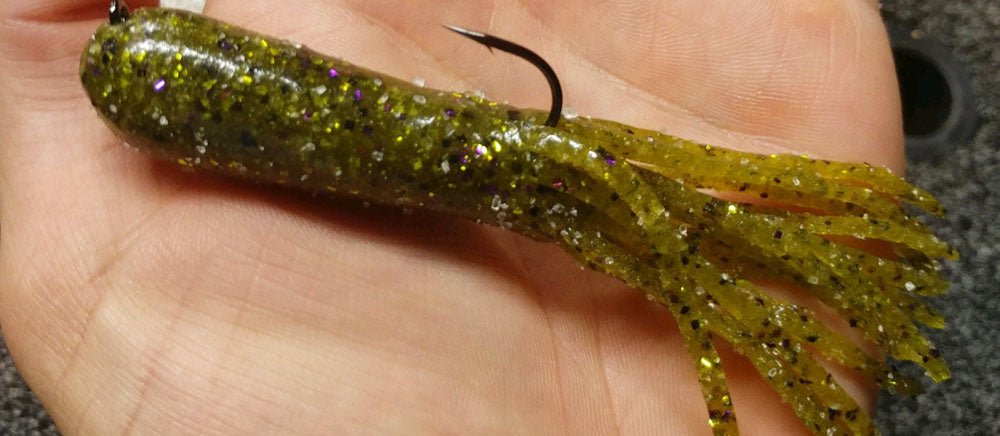Spring Tube Tactics for Bass
Let's dive into some highly effective tube bait tactics for bass fishing during the spring season. Tube baits can be incredibly productive when rigged the right way, and over the years, I’ve found a few specific setups that work best during this time of year.
Classic Jig Head Rig
One of the most reliable ways to rig a tube is with a jig head featuring a 90-degree eye. This method has been around since tubes first gained popularity in the 1980s. The eye of the jig head sticks straight up and slightly back from the tube’s front, creating a unique action when fished on a slack line.
For the best results, use a spinning setup—a medium-light power, medium-light action rod, ideally around seven feet in length. Pair it with six-pound fluorocarbon line (though you can go up to ten pounds if you prefer). The lighter line enhances the bait’s movement, making it more enticing to bass. When casting, use an eighth-ounce jig head at most, with a weight range between a sixteenth and an eighth ounce.
The real magic of this setup lies in its falling motion. As the tube descends, it spirals downward in a way that no other bass lure mimics. This “death spiral” often triggers aggressive strikes from bass. It’s a fantastic approach for targeting fish around docks, skipping under overhangs, or fishing along weed edges and flats with scattered structure. This setup is particularly effective in clear water, where bass can easily see and react to the bait.
When choosing colors, green pumpkin is always a solid option. Another favorite is a shade called “old ugly,” which blends baby diaper yellow and green pumpkin—an unusual combination that bass love. Whether you opt for salt-and-pepper flake or a plain variation, this color works well in most spring conditions.
60-Degree Eye Jig for a Different Action
If you’re looking for a variation, try a jig head with a 60-degree eye and a slightly oval or egg-shaped head. This setup alters the tube’s action, making it glide rather than spiral. It’s perfect when covering water quickly or mimicking a fleeing baitfish.
Simply cast it out and give it small twitches. The bait will glide forward before slowly descending again. This creates an irresistible motion resembling a disoriented minnow—easy prey for bass. Just like the previous setup, this technique works well in the same areas: docks, submerged cover, and rocky flats.
For extremely clear water, switch to a more translucent tube with smoke or clear colors, perhaps with some salt-and-pepper or gold flake for added flash. The subtle sparkle helps catch the attention of nearby bass.
Split-Shot (Mojo) Rig for Smallmouth
Another highly effective spring tactic, especially for smallmouth bass, is rigging a tube on a split-shot or Mojo rig. This setup features a small cylindrical weight—usually an eighth ounce or less—positioned about two to two-and-a-half feet above the hook. The tube can be rigged weedless, making it an excellent choice for fishing through vegetation, rocky terrain, and submerged brush without snagging.
This method is particularly productive in the early spring and remains effective up to the spawning period. It allows you to cover water efficiently while maintaining finesse, which many anglers overlook. Even though finesse fishing is often associated with slow presentations, this setup can be worked quickly to locate aggressive bass.
A simple trick to enhance this rig is inserting a small piece of a toothpick into the back of the tube to keep its cavity open. This causes a slight delay in the bait’s descent, creating an action where the tube briefly suspends before sinking again. This unexpected movement can trigger vicious strikes, especially when bass are hesitant to bite.
Flipping and Pitching Tubes
A lesser-used but highly effective springtime technique is flipping and pitching tubes into heavy cover. Many anglers believe you need specialized thick-walled tubes for this approach, but standard tubes work just fine. The only real difference is durability—thicker tubes might last a bit longer, but the effectiveness remains the same.
For this method, Texas-rig the tube with a quarter-ounce to three-eighths-ounce bullet weight and a heavy-gauge hook, such as a Trokar flipping hook. This setup makes the bait completely weedless, allowing you to target bass staging near flooded timber, brush piles, and dense vegetation before moving into shallow spawning areas.
Because you’re fishing in thick cover, you’ll need a sturdy setup. A seven-foot-four, heavy power, fast-action rod paired with 50-pound braided line is ideal. This allows you to muscle big bass out of their hiding spots with ease.
Final Thoughts
Each of these tube fishing techniques can be incredibly productive during the spring. Whether you’re targeting bass in clear open water, covering flats and rocky areas, or flipping into dense cover, these rigs give you the versatility to adapt to different conditions. Give them a shot this season and watch your catch rates soar!

